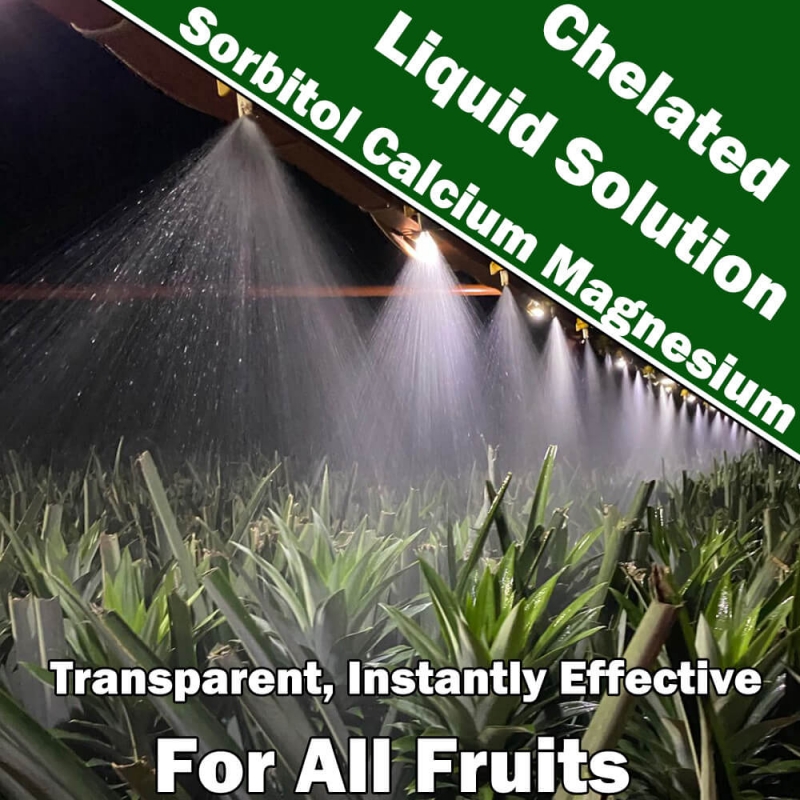



Sorbitol Calcium Magnesium Liquid Solution For All Fruits
(Optima Fruit Quality Enhancer )
SORBITOL CA+MG
Contains high concentration of sorbitol, Magnesium and Calcium.
Clear and transparent liquid solution.
Significantly improves fruit quality in juicier and sweeter flesh.
Brings in a better fruit shape, aroma, taste and color.
Enhance the cell wall strength, less damage in transportation.
Alleviating drought stress.
Extremely prompt acting nutrients for plants to absorb.
About Sorbitol Calcium Magnesium Liquid Solution
It is a precisely formulated liquid solution containing sorbitol, calcium, and magnesium. These three nutrients interact synergistically, significantly enhancing the fruit quality.
It is recommended to be used during the fruit swelling stage to prevent fruit cracking and reduce economic losses.
As a photosynthetic product and transport substance
In many plants, sorbitol is one of the products of photosynthesis. For example, in plants of the Rosaceae family such as apples and pears,
leaves produce sorbitol through photosynthesis and then transport it to other parts of the plant, like flowers, fruits, and roots.
This transport function is similar to that of sucrose in other plants, providing the carbon source and energy required for plant growth and development.
The transportation of sorbitol in plants occurs through the phloem. It can diffuse between cells along the concentration gradient
or be actively transported via specific transporter proteins. During the transportation process, sorbitol supplies nutrients to the cells along the way, supporting their metabolic activities.
Regulating osmotic pressure When plants are dealing with environmental stresses, sorbitol plays a crucial role in regulating osmotic pressure.
Under environmental conditions such as drought or high salinity, the concentration of sorbitol in plant cells will increase.
For example, in plants growing in saline-alkali soil, the accumulation of sorbitol in cells can reduce the water potential inside the cells,
enabling the plants to absorb water from the high-salt external environment and maintain cell turgor and normal physiological functions.
This osmotic regulation function helps plants maintain the water balance of cells, preventing cells from shriveling due to water loss
and thus avoiding plant wilting. It's like building a "small reservoir" inside plant cells. When the external environment is unfavorable for water absorption,
sorbitol can help the cells retain water.
About Sorbitol
Participating in carbon and energy metabolism
Sorbitol can serve as an intermediate product in plant carbon metabolism. It can be converted into other sugars or organic compounds
by intracellular enzymes and participate in energy metabolism processes such as plant respiration. For example, sorbitol can be
converted into fructose under the catalysis of certain enzymes and then enter the glycolysis pathway to generate energy substances
such as ATP (adenosine triphosphate) for plant cells.At the same time, the metabolic process of sorbitol is also related to other metabolic pathways in plants,
such as nitrogen metabolism. It can regulate the carbon-nitrogen ratio in plants, affecting plant growth and development,
such as promoting flower bud differentiation and fruit development.
Function as a signaling molecule
An increasing number of studies suggest that sorbitol may act as a signaling molecule in plants.
When plants are stimulated by external environmental factors, such as changes in light, temperature,
or pathogen invasion, changes in the concentration of sorbitol may trigger a series of signal transduction pathways in plants.
These signal transduction pathways can regulate plant gene expression, causing plants to produce corresponding physiological responses,
such as enhancing the expression of stress-resistant genes, thus improving the plant's resistance to adverse environments or
activating the plant's defense mechanisms against pathogens.
About Liquid Calcium
Strengthening plant cell walls:
Calcium is an essential component of plant cell walls. It mainly exists in the form of calcium pectate in cell walls, linking pectin molecules together like "glue",
thus enhancing the stability and mechanical strength of cell walls. For example, during the growth of vegetables (such as Chinese cabbage and kale),
sufficient calcium can keep the leaves upright and reduce the phenomena of leaf wilting and soft rot caused by weak cell walls.
Promoting root development:
Calcium is crucial for the growth and development of plant roots. It can regulate the division and elongation of root tip cells, promoting the formation of root morphology.
For example, during the seedling stage of fruit trees (such as apple trees and citrus trees), an appropriate supply of calcium can make the roots
stronger and increase the root absorption area, enabling better absorption of water and nutrients from the soil.
Improving fruit quality:
During fruit development, calcium can prevent fruit softening and decay. For fruits prone to physiological diseases, such as blossom-end rot in tomatoes and bitter pit in apples,
supplementing calcium can significantly reduce the incidence of these diseases. This is because calcium can stabilize the cell membrane structure
and maintain the normal function of cells, preventing the leakage of substances inside fruit cells.
Enhancing plant stress tolerance:
Calcium participates in the stress-tolerance physiological processes of plants. Under environmental stresses (such as drought, high temperature, and salinity),
calcium can regulate the physiological and biochemical reactions within plant cells and maintain the ionic balance within cells. For example, during drought stress,
calcium can help plant cells maintain turgor pressure and reduce water loss, thus enhancing the plant's tolerance to drought.
Functions of magnesium
Participating in photosynthesis:
Magnesium is the central atom of chlorophyll and an important part of the chlorophyll molecule. It can promote the synthesis of chlorophyll
and ensure the normal progress of photosynthesis. For example, during the growth of food crops such as rice and wheat, sufficient magnesium
supply can keep the leaves green, improve photosynthetic efficiency, and increase the accumulation of organic matter.
Activating enzyme activities:
Magnesium is an activator of many enzymes and can participate in many important physiological metabolism processes in plants.
For example, in the plant respiration and carbohydrate metabolism, magnesium ions can activate related enzymes and promote the
synthesis and transportation of sugars. Some enzymes related to nucleic acid synthesis in plants also require magnesium ions for activation,
which is of great significance for plant growth and development.
Promoting protein synthesis:
Magnesium can promote protein synthesis in plants. It plays a role in maintaining the structure and function of ribosomes,
as ribosomes are the sites of protein synthesis. During the growth of leguminous plants (such as soybeans and peas),
sufficient magnesium supply helps to increase the protein content of seeds.
Guaranteed Analysis
Nitrogen (N)---------------------7.3%
Calcium (Ca)---------------------150 g/L
Magnesium (Mg)----------------20 g/L
Sorbitol Alcohol-----------------95~100g/L
Directions For Use
Applicable to a wide range of fruits, including but not limited to apples, pears, pineapples, grapes, and bananas.
For foliar application, during the early fruiting stage, spray 3 to 4 times, and during the fruit swelling stage, also spray 3 to 4 times.
The recommended dilution ratio is 1:1000 to 1:2000.
© Copyright - 2021 | All Right Reserved. Designed By rutombio.com